Shipping is a process that businesses use to send products from one place to another. There are many things to consider before shipping, such as packaging and shipping costs. Here are five considerations you should make before shipping your product.
Packaging
The first thing you need to consider is the packaging. How will you package your product so that it arrives safely at its destination? You’ll need to take into account the size and weight of your product, as well as any special shipping requirements (such as Fragile or This Way Up).
Packaging can be in the form of pallets and pallet wrapping or the inner packaging inside boxes such as bubble chips. These can be used commercially and domestically to protect products. Businesses will use sturdy wooden pallets to group products together and then cover them in pallet wrapping to keep the goods from moving about within the pallet. Then there is another reason to use pallet wrapping in that it shelters goods from rainwater. Its properties are effective in protecting the goods that it surrounds. This goes for a multitude of products it is used on.
For small products, you need something to hold them together inside the pallets. Custom wrapping is quite popular these days, especially for perishable goods. People don’t want their food and other items to arrive in a blank silver bag. They want colors and fun that also provide ample protection the whatever is within. Take cannabis, for instance. A very sensitive good that needs to be packaged in polyester film before it is shipped anywhere. That is why so many cannabis businesses get a mylar bag custom designed and use it as their inner packaging inside whatever boxes they decide to ship the products in. This makes for not only an effective solution but a cost-effective one.
Shipping Costs
The next thing to consider is shipping costs. How much will it cost to ship your product? You’ll need to take into account the shipping method you choose (such as air, ground, or express), as well as the size and weight of your product.
The total shipping cost is, of course, the total cost of the methods used for transportation and the packaging material that is chosen. Keep in mind that the speed of transportation can also be influenced by the packaging methods used. That said, there are strategies businesses can adopt in order to reduce shipping costs and improve accuracy. For instance, taking advantage of shipping software can allow companies to automate the shipping process, enable businesses to compare rates, track shipments in real-time and manage logistics more efficiently. This approach can thereby allow businesses to cut costs and increase their return on investment.
Keep in mind that products being transported on the backs of ships or open train carriages may not be as protected as when inside lorries, vans, or aircraft. There will be times in every situation when products need protection from the weather but not to such a large extent as when in the open. Packaging can take care of every situation and provide the reassurance that all has been done to ensure a product arrives safe and in the condition it left the factory production line, warehouse, or shop.
Check Compliance
Before sending out your products or services, it’s essential to make sure your business follows all the rules. This means checking if you comply with local, state, and national laws that apply to your industry. If your business operates globally, it’s crucial to understand international trade regulations too. Taking these steps helps you avoid legal issues and builds trust with customers and partners. By being proactive about compliance before shipping, your business can navigate rules and regulations more smoothly, setting the stage for long-term success in the global market.
One instance of this could be that the US customs requires electronic submission of certain advance cargo information, which is also known as the Importer Security Filing (ISF) requirement. Hence, ISF Filing should be done a minimum of 24 hours before the vessel reaches the port. In this manner, it’s necessary to stay compliant with all the regulations in different places, depending on where the goods are being shipped.
Weight Considerations
Weight is indeed a critical factor to bear in mind when it comes to shipping your products. It not only impacts shipping costs but also influences the choice of transportation method and the type of packaging required. For heavier items, the expenses can significantly rise, especially if you choose air freight as your mode of transport. Moreover, the weight of your shipment plays a crucial role in determining the packaging materials needed to guarantee the safe and secure transit of your goods.
Having said that, it’s also important to be aware of the weight restrictions imposed by various carriers and transportation modes. Exceeding these limits could result in additional fees or delays in the shipping process. Properly assessing and managing the weight of your products is essential to streamline the shipping process, control expenses, and ensure that your items reach their destination intact.
However, in some cases, when dealing with exceptionally heavy cargo, you might also want to explore specialized companies that focus on heavy weight container cargo. These companies possess the expertise and equipment necessary to handle Overweight transportation and can offer tailored solutions to meet your specific shipping needs.
Delivery Time
Another consideration is delivery time. How long will it take for your product to arrive at its destination? The shipping method you choose will significantly affect delivery time. It all depends on the time specified to those buying the product. If they are prepared to wait, then they can pay for a cheaper transportation method. Whatever is decided, it pays to spend the money on the protection surrounding the product. However long something takes to arrive, the most important thing is that it does not have to be sent again because it got damaged. This would be a waste of time and effort and increase the costs.
Tracking
Finally, you’ll want to consider tracking your delivery or shipment. There are many shipping options available that offer tracking. So, consider this when making your shipping decision. It can be worth the extra cost to have a more precise time for delivery.
It is helpful for businesses and their stock control procedures to know just when they can expect a product. Delivery timescales can be vague and a little unpredictable, so knowing where a product is at every step of its journey is invaluable. We can plan better and inform customers just when a delivery is likely. People will be prepared to wait if they just have a date to work to.
Conclusion
Shipping can be a complex process, but by considering these four factors, you can make sure that your shipping goes smoothly. Most importantly, don’t skimp on the packaging and end up sending something twice. Your reputation might be severely impacted.



